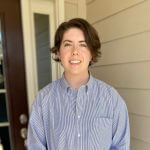James Dilzell
Gypsum, Colorado
James grew up in Cleveland, OH, a city nestled along a Great Lake. He spent much of his time exploring the local parks and took a Field Ecology class his freshman year of high school that impacted the course of his life more than he thought. Fast forward a few years, he received a Bachelor of Science in Environmental Engineering from The University of Alabama and spent summers working in Montana. Rather than attending graduation, he packed up his station wagon and drove west to Colorado. James lives in Eagle, and while not talking about water, he can be found cooking, biking, hiking, skiing, camping and drinking as much coffee as he can.
This interview was conducted by Carly Schmidt on March 24, 2023. Learn more about James’s work at https://erwc.org/.
Carly Schmidt: What is your role at Eagle River Watershed Council and what are some of your current priorities?
James Dilzell: I am the executive director for Eagle River Watershed Council and number one priority for me is to learn. This role is very new and exciting and it’s interesting to know how much control I have over what we do. A top priority is leveraging our water quality monitoring and assessment program. This is a program that’s been going on since 1998. We have a lot of data from partners throughout the watershed and the state, a lot of great information. There’s an opportunity to communicate this to our community and really leverage this data to make sure that we are prioritizing the right restoration projects. We do great work at ERWC but a lot of the work is waiting for people to come to us. We want to be a more trusted partner and we have a lot of value to add to these conversations. I think our water plan will help with that traction.
Carly: I didn’t realize the Executive Director role was so new for you! You were in an education role before this, right?
James: That’s right, I was Education and Outreach Coordinator and then Manager for 6 months before this.
Carly: What was the transition to the Executive Director role like? How has your day-to-day changed?
James: I am pretty surprised by the amount of administrative work that has to happen! You romanticize your job description when applying for a position. I was like, “Wow, I’m just going to be talking about the watershed all the time and I’ll be out in presentations,” and I do get to do that a lot, which is a benefit coming from the world of education because I’m not scared of public speaking. But there’s so much on the back end that I didn’t ever see my boss doing.
Another thing that was surprising was how interested our Board is in the direction that I want to take the organization. They know I’m young and new to leadership, but they trust my instincts. They’re not leading from the top down by any means, which I have appreciated.
Carly: How has ERWC been involved in water planning and assessment over the years?
James: There’s been quite a few plans and assessments done in the Eagle River Watershed. We did not go into our most recent plan without background information. A current snapshot of the Eagle River includes an Eagle River Watershed Plan, a couple of ditch assessments; some towns have water efficiency plans and source water protection plans; mostly looking at water quality and current conditions. Our most recent Eagle River Community Water Plan that we started in 2018 is looking ahead. It’s not just looking at past data, past water quality information, and past flows. The model that was created looks ahead at future conditions that take into account the values of our community that we learned about through community input like agriculture, viewscapes, drinking water supplies, and our wildlife and biodiversity. And, of course, it takes climate change into account. What are we going to see in a hotter, drier future? What is our community going to look like? It’s estimated that our population will double by 2050. And, looming in the upper reaches of our watershed, the Eagle River Memorandum of Understanding includes another potential reservoir that diverts 20,000 acre feet of the watershed. What would local streams look like if that happens? We’re looking at the model outputs and figuring out how we can mitigate these kinds of undesirable conditions.
Carly: What inputs were you looking for from the community and how did you go about getting folks involved in the development of the Community Water Plan?
James: We knew what we wanted to protect at the Watershed Council – fish and stream systems – but these are all related to bigger picture community values. We wanted to know what communities care about. What are their priorities? What value does the Eagle River hold in our community and what do they want to prioritize as we look to the future? We asked about their perceived risks that would impact the things they care about. Is it climate change or population growth or future diversions? This helped us understand what to communicate about at the end of this, what are the actual risks that people need to know about and understand, and connect the dots there.
In addition to surveys, we did a dot exercise during some in-person meetings. We invited folks to come and visualize their values. These weren’t super well-attended meetings so, instead of keeping at something that wasn’t working, we decided to take the surveys to people. We worked with another non-profit that ran summer camps so we were there at drop-off and said, “Hey, parents, as you’re dropping your kids off, what do you think is important about our rivers?” People would vote and contribute to the dot exercise. We had close to 500 participants total, so this approach worked pretty well.
We did also translate our outreach materials into Spanish because the Spanish speaking community makes up 25% of the population here. But, anecdotally, we know it’s much higher than that. We leveraged a partnership with another local group, Eagle Valley Outdoor Movement, that is focused on breaking down barriers with the Spanish speaking community. We didn’t get a ton of responses there but, overall, we feel like this plan did get a pretty good voice from the community.
Carly: What are your goals for the community water plan? How are you hoping to leverage all this great local knowledge into something really impactful for the watershed?
James: The goals of this plan are different from previous plans because we are considering past, present, and future impacts, as well as ecosystem and human river health values, with the goal of correcting historical degradation but also preventing undesirable future conditions. At the root of the Community Water Plan, we needed to know how we can get ahead of the issues that we know are coming. We can’t stop climate change alone, we can’t stop people from moving here, we can’t stop any future diversions within existing water rights, so how much control do we have and where can we find our power? The Plan is a way to look ahead and figure out where we should be focusing our efforts.
Carly: Through those dot exercises, what priorities came out on top.
James: Wildlife and biodiversity was our top priority, based on these dot exercises. The population in this area is pretty informed. People here are pretty connected to the outdoor world. We play outside all weekend, lots of people recreating on the rivers, and people recognize the connection. Drinking water supply was #2, agriculture was #3, angling was #4, aesthetics was #5, and recreational boating was #6. Non-agricultural irrigation was at the very bottom with 3 total responses. Golf courses and other amenities like fountains were also very low.
Carly: You mentioned population growth as a potential risk in the area. You are working in such a unique context where tourism plays a role as well. How is tourism factored into the water plan? Do you engage visitors at all on the impacts of tourism on this place that they love to visit?
James: Tourism is huge. It is our top economic driver here in Eagle County. We have 55,000 residents here but the infrastructure is designed for many more people. We’ve talked internally about how to communicate the risks to visitors because of their impacts to our watershed, whether they’re hiking or buying bottled water or traveling to get here. We haven’t yet put in the time to engage this group. We’re still a pretty small organization and entering a new chapter in terms of figuring out our growth. Our main priority right now is connecting with folks who are here on a permanent basis, relying on this water source and this watershed, and how they can take an active role in protecting it. But it is a fine line because we have so many second homeowners that live here two weeks out of the year, yet they’re watering lawns year-round. They have the funds and don’t really care about their water bill. We’re trying to figure out how to shift, and we haven’t figured it out yet but we’re getting there.
Carly: Looking at your instagram presence, it seems like there is a lot of engagement from residents in local clean ups.
James: That’s refreshing to hear because I’m a person who always thinks it’s never enough. We do have a really good base of volunteers. Over 1,000 people come out every year to do cleanups, which is great because the trash on our highway has a pretty good chance of ending up in the river through stormwater infrastructure. People care about the river. Part of our success and engagement is because of how ERWC started. We are a conglomeration of 2 entities created after the Eagle Mine spill in the late 80s. The spill area was, and still is, designated as a superfund site. People and businesses came together to make sure that the clean up efforts were done to the benefit of the community. We started as a community grassroots organization. People wanted to protect their river and I think that carried into local values today.
Carly: What is needed to meet the level of engagement you need to carry out the goals of the community water plan?
James: Something I prioritized as Executive Director is awareness and marketing. People know about our rivers, you drive by them everyday on your way to work, but not a lot of folks know that the Watershed Council exists. We’re working toward awareness not only for our organization but for the ways that folks can participate is really important. We’ve hired a marketing contractor who can help get more folks to our fundraising events, clean ups, and education events. How can we let people know that there are ways they can engage? Everything we have can expand with more funding, more participation, and more donors. Awareness is the big thing right now.







